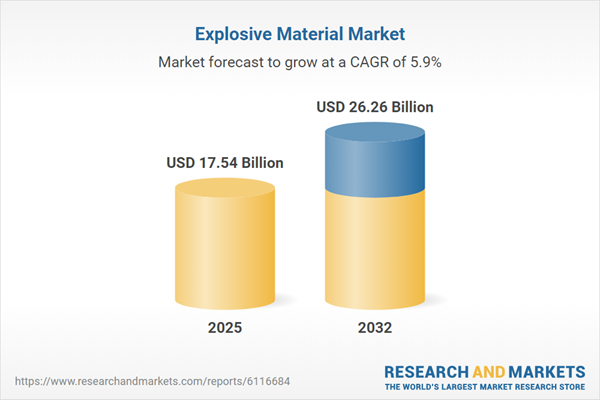Speak directly to the analyst to clarify any post sales queries you may have.
The explosive materials market is evolving rapidly, driven by continued innovation, regulatory shifts, and changing global dynamics. Senior executives seeking strategic growth opportunities must navigate complex developments in technology, sustainability, and supply chain resilience to remain competitive.
Market Snapshot: Explosive Materials Market Overview
The explosive materials market expanded from USD 16.60 billion in 2024 to USD 17.54 billion in 2025 and is projected to reach USD 26.26 billion by 2032, reflecting a CAGR of 5.89%. This growth underscores robust demand across infrastructure, defense, and mining, as well as the implementation of advanced formulations and supply chain realignment. Shifts in trade policies and strengthened compliance standards continue to reshape the competitive landscape, prompting manufacturers and end users worldwide to innovate and adapt.
Scope & Segmentation
- Product Types: High explosives (HMX, PETN, RDX, trinitrotoluene), primary explosives (diazodinitrophenol, lead azide, mercury fulminate), propellants (composite, double base, nitrocellulose), and pyrotechnics (fireworks, illuminants, signal flares).
- Formulations: Ammonium nitrate fuel oil, dynamite, emulsion explosives (continuous phase, microemulsion), plastic explosives, and slurry explosives.
- Applications: Aerospace, construction (demolition, quarrying), military (ammunition, demolition charges), mining (surface and underground), and oil and gas (well perforation, stimulation).
- Distribution Channels: Direct sales, distributors, and government tenders.
- End Users: Construction firms, government and defense divisions (air force, army, navy, marine corps), mining companies, and oil & gas operators.
- Regional Analysis: Americas (United States, Canada, Mexico, Brazil, Argentina, Chile, Colombia, Peru), Europe (United Kingdom, Germany, France, Russia, Italy, Spain, Netherlands, Sweden, Poland, Switzerland), Middle East (UAE, Saudi Arabia, Qatar, Turkey, Israel), Africa (South Africa, Nigeria, Egypt, Kenya), Asia-Pacific (China, India, Japan, Australia, South Korea, Indonesia, Thailand, Malaysia, Singapore, Taiwan).
- Key Companies Studied: Orica Limited, MaxamCorp Holding S.L., Enaex S.A., Austin Powder Company, Chemring Group plc, Nippon Kayaku Co. Ltd., Ensign-Bickford Industries, AECI Limited, AMA Group, Bulk Mining Explosives Ltd., China Poly Group, Dyno Nobel Group, EPC Groupe, Hanwha Corporation, IDEAL Industrial Explosives, Johnson Hi-Tech, Kayaku Japan Co., Keltech Energies, NITROERG S.A., NOF CORPORATION, PT. Dahana, Sasol Limited, Saudi Chemical Company, and others.
Key Takeaways for Decision-Makers
- Advances in nano-scale and polymer-bonded energetic materials are enhancing product performance, enabling precise control, and driving new application areas.
- Digitalization across the value chain is streamlining quality protocols, enabling predictive maintenance, and improving manufacturing productivity and safety.
- Heightened regulatory pressures are accelerating innovation in bio-based and eco-friendly formulations, positioning sustainability as a key market differentiator.
- Geopolitical trends and evolving trade policies require manufacturers to diversify sourcing strategies, explore regional partnerships, and strengthen risk mitigation efforts.
- Segmentation by product type, formulation, application, and regional specificity reveals targeted growth opportunities for tailored market entry strategies and optimized operations.
- Strategic partnerships, investment in R&D, and integration of technical services increase resilience and customer loyalty.
Tariff Impact on the Explosive Materials Market
Recent tariff implementations by the United States on select precursor chemicals and explosive materials have redefined global supply chains. Market participants are revising sourcing, restructuring contracts, and emphasizing domestic capacity. Regions dependent on imports are accelerating process optimization and seeking alternative formulations, while collaborative ventures between North American and overseas firms are advancing localized technology transfer and procurement platform innovation. These dynamics are prompting industry players to adjust their operational models to maintain resilience under evolving trade policies.
Methodology & Data Sources
This report relies on a robust multi-stage research methodology. Secondary sources such as industry white papers, regulatory filings, patents, and corporate disclosures establish the foundational context. Primary research features executive interviews and technical insights, which are cross-validated against proprietary databases and financial records through triangulation and peer review, resulting in accurate and actionable findings.
Why This Report Matters
- Enable actionable, data-driven strategic decisions by illuminating critical drivers, technologies, and market entry risks across major regions and applications.
- Benchmark leading companies’ innovation, partnership models, and investment strategies to support long-term resilience and customer value.
- Understand the impact of regulatory developments, tariff measures, and sustainable practices to optimize growth and minimize disruption.
Conclusion
The explosive materials market is transforming, shaped by technology advancements, regulatory evolution, and regional differentiation. Senior decision-makers equipped with comprehensive market intelligence are better positioned to capitalize on growth, drive innovation, and sustain resilient operations in an increasingly complex environment.
Table of Contents
3. Executive Summary
4. Market Overview
7. Cumulative Impact of Artificial Intelligence 2025
Companies Mentioned
The companies profiled in this Explosive Material market report include:- Orica Limited
- MaxamCorp Holding, S.L.
- Enaex S.A.
- Austin Powder Company
- Chemring Group plc
- Nippon Kayaku Co., Ltd.
- Ensign-Bickford Industries, Inc.
- AECI Limited
- AMA Group
- Bulk Mining Explosives Ltd.
- China Poly Group Corporation Ltd.
- Dyno Nobel Group
- ENAEX S.A.
- EPC Groupe
- Hanwha Corporation
- IDEAL Industrial Explosives Ltd.
- Johnson Hi-Tech PTY LTD
- Kayaku Japan Co., Ltd.
- Keltech Energies Limited
- NITROERG S.A by KGHM Polska Miedź S.A.
- NOF CORPORATION
- PT. Dahana
- Sasol Limited
- Saudi Chemical Company
Table Information
| Report Attribute | Details |
|---|---|
| No. of Pages | 181 |
| Published | October 2025 |
| Forecast Period | 2025 - 2032 |
| Estimated Market Value ( USD | $ 17.54 Billion |
| Forecasted Market Value ( USD | $ 26.26 Billion |
| Compound Annual Growth Rate | 5.8% |
| Regions Covered | Global |
| No. of Companies Mentioned | 25 |









